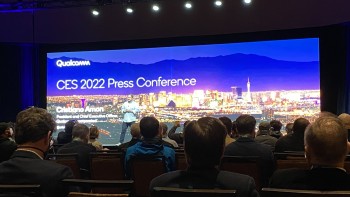Since announcing that this year’s CES would take place “in-person,” the Consumer Technology Association (CTA) was clear that health safeguards would be paramount. Ultimately, attendees are required to demonstrate vaccination using the CLEAR app, which incorporates AI to verify authentic vaccination cards, among other safeguards. And masks are mandatory. So even with Omicron raging, my back-of-the-envelope calculus is that this is no less safe than biking to the pizza shop.
Still, many big players pulled out. Amazon, Google, Microsoft, Twitter, and T-Mobile, whose CEO was scheduled to give a keynote, are not here. Qualcomm, Samsung, and LG are present and showing.
There are changes in the media workroom, too. Ordinarily, CTA provides industry analysts (which is how I come to be here) with some rudimentary office supplies and a “security friendly” clear plastic backpack. Not this year. Staff predicted those accoutrements will be back when things “return to the normal.” In the meantime, I was offered a COVID self-test kit upon registration. So, there’s that.
Despite the thinner crowds; despite the masks; despite the sense that a lot of people are using this meeting to dip their foot back into the conference pool, there is the customary vibe of excitement coursing through the meeting.
How else to characterize a pair of AR/VR glasses that weigh less than five ounces but which are the next step in telehealth? XRHealth previewed the next iteration of its already impressive VR unit that gathers 500 more data points than a 2D telehealth interaction. The technology moves telehealth beyond two-way video and enables clinicians to assess cognitive reactions alongside physical health, key functions in treating post-stroke or concussion patients. The VR settings also enable broader forays into using telehealth for mental health therapy, including group counseling sessions. These can be game changers for rural spaces that lack adequate access to specialists and physicians.
Ag manufacturer John Deere continues its CES presence, this year showing off an autonomous driving tractor that uses six pairs of stereo cameras to support “see and spray,” which distinguishes between weeds and crops and then applies the correct chemical “on the go” as the tractor moves in the field. The tractor “knows where it is and where it is authorized to be,” and incorporates anomaly recognition systems to avoid hazards. Farmers can control the 40,000 lb. machine remotely.
And, in Tuesday’s keynote, Samsung featured TV remote controls that rely on solar or artificial light for power, potentially eliminating forever that dreaded moment when your batteries die and you can no longer change the channel from the couch. Samsung CEO Jong-Hee “JH” Han also announced developments leading to units that will draw power from RF signals emanating from routers and TVs. The company articulated its goal to reduce reliance on disposable batteries.
In all, Day One of CES offered a taste of meaningful technology – healthcare, ag, and sustainability. CES may be a bit less lively than in prior years, but it is a good and needed step toward bringing us together again, however carefully and cautiously, to the edge of an exciting future.


